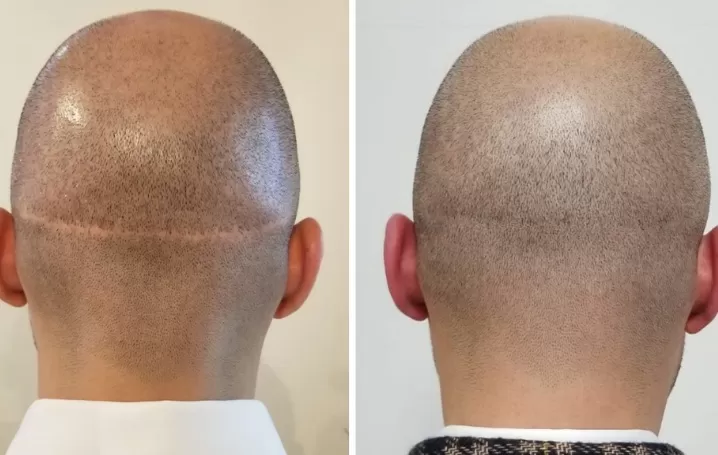Hair Transplants vs a Scalp Tattoo

A scalp tattoo is a permanent solution for hair loss and scar coverage. At Scalp Micro USA, we offer this minimally invasive treatment option to men and women who want to create the appearance of fuller, natural hair. It is a non-surgical alternative to other hair restoration treatments like hair transplants. Here are some of the differences between micropigmentation and hair transplants:
Treatment Preparation
There is minimal pre-treatment preparation for scalp tattoo clients. The individual should schedule a consultation with an artist to confirm their hair goals are attainable. On the day of the treatment, clients should avoid moisturizing the scalp or taking any medication that could thin the blood. These steps help create a clear work surface for the artist and reduce the risk of bleeding during treatment. Clients with bald hairstyles should avoid shaving the scalp for at least 24 hours before micropigmentation to prevent skin irritation. At Scalp Micro USA, our team of artists will inform you of any additional preparation steps if needed.
To prepare for hair transplants, clients must complete a consultation with a transplant specialist to determine their candidacy. On treatment day, clients should arrive at the clinic with washed and dried hair. The hair should also be free from any pigment or fibers used to add density. Not using hair or skin products before treatment keeps the transplant sites clean and free from potential irritants that could cause complications. Transplant specialists may recommend preparation tips to follow for several weeks leading up to the surgery. These include avoiding blood-thinning medications and other non-approved drugs. They may also recommend cutting the hair short, especially on the sides and back of the head.
Procedure Steps
The first step in a scalp micropigmentation treatment is to create a custom hairline or fill-in design for the client. At Scalp Micro USA, we use advanced mapping technology to capture an accurate image of the client’s scalp. We use this imaging to test potential hair designs online. This allows clients to view the expected results and choose a hairline that matches their style and natural growth patterns. Once the client has chosen a hairline design, our artists will clean the scalp, trace the design, and prepare their instruments. We can then begin placing tiny dots of pigment along receded hairlines, over scars, and in thinning areas to create the illusion of thicker hair.
Hair transplant specialists will assess the client’s hair to identify viable donor follicles. The donor follicles must come from an area of the scalp where hair growth is permanent and not affected by thinning or balding, like the sides and back. Specialists then apply local anesthesia and remove healthy follicles in grafts of several hair strands at a time. They place the individual grafts carefully in the transplant site to fill in gaps and create the appearance of a natural growth pattern.
Results
Scalp micropigmentation results are immediate. Clients don’t need to wait for days or weeks to see the effects. There may be some redness on the skin after treatment, but it should subside quickly. This procedure is helpful for men and women with long, short, and shaved hair. Long hair fill-ins result in thicker-looking hair along part lines and thinning areas. Individuals with alopecia and other genetic hair loss conditions can maintain the appearance of a full head of hair for 4-6 years with micropigmentation.
It may take several months after a hair transplant for clients to notice growth. Signs of hair growth indicate whether the follicles are adapting to their new location successfully. Clients may have temporary skin inflammation and a visible scar where the donor follicles originated. At Scalp Micro USA, we can perform micropigmentation on a fully healed transplant scar to camouflage it with the surrounding hair.
Aftercare
A key part of caring for a new scalp tattoo is to keep the treatment site clean, moisturized, and away from direct sun rays. Wash the area gently with mild soap and water to protect the sensitive skin. Wear sunscreen and hats when going outdoors to keep the sun’s damaging rays off of the healing treatment area. Once the treatment site is fully healed, clients can shave their heads every few days to maintain an even, buzzed look.
Hair transplant clients should rest for several days after the treatment. This allows the skin to heal properly without further irritation. During the first weeks after treatment, clients may notice their transplanted hair is shedding. Shedding is a natural phase in the hair growth cycle, and clients should be patient as the hair follicles begin to grow again. Being gentle with the donor and transplant sites when washing or styling the hair helps clients avoid irritating the skin or new hair follicles.
Learn More About Getting a Scalp Tattoo
Scalp Micro USA has been helping clients achieve their hair restoration goals for over 10 years. We have clinics in New York, Los Angeles, Houston, Chicago, and South Florida. Our team of artists is available for in-person, phone call, and Facetime consultation appointments. Visit one of our clinics or contact our team today to schedule a consultation and learn more about our services.

Tired of hair loss?
Get the perfect hairline, 100% guaranteed, with our scalp
micropigmentation treatment that is customized just for you. No more
crazy combovers. No more ineffective medications. Just results.